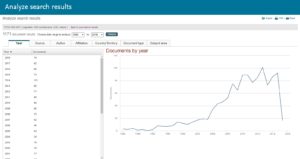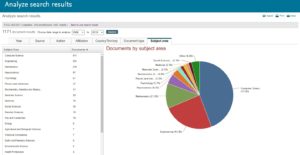Scopus is one of those research gems that many people skip over because they don’t know what it is and how it can be helpful. If you’re dealing with the life, social, physical, or health sciences, this should be one of the first resources to check.
The sheer size Scopus is impressive; it covers over 22,000 journals, 150,000 books, and conference materials for a combined 69 million records. It features smart tools to track, analyze, and visualize the world’s research.
There are five types of quality measures for each title: the h-index, CiteScore, SJR (SCImago Journal Rank), SNIP (Source Normalized Impact per Paper), and the relatively new PlumX Metrics (which measures usage, captures, mentions, social media, and citations). Below are two examples of how search results can be automatically analyzed and viewed in Scopus.
Scopus is easy to navigate, and the ability to search both forward and backward from a particular citation is very helpful. Searching forward refers to the ability to follow who has cited an article. Searching backward refers to the ability to view the references in a source’s bibliography.
Because there is such a broad range of research fields covered in Scopus, the nature of this database is multidisciplinary and allows researcher to easily search outside of his/her discipline. Many of the references of specific records are hyperlinked, in addition to any citing literature that is also hyperlinked.
To access Scopus, visit https://library.willamette.edu/ref/dbs/atoz.php?q=s.
Note: Scopus logo is from the Central European University Library web site.



